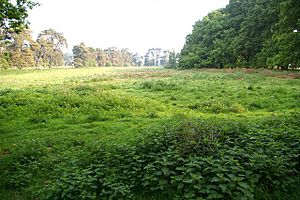Stanford Training Area SSSI facts for kids
| Site of Special Scientific Interest | |
 |
|
| Area of Search | Norfolk |
|---|---|
| Interest | Biological Geological |
| Area | 4,678.0 hectares (11,560 acres) |
| Notification | 1999 |
| Location map | Magic Map |
The Stanford Training Area SSSI is a very special place in Norfolk, England. SSSI stands for Site of Special Scientific Interest. This means it's a protected area because it has unique plants, animals, or geological features.
This site is part of a larger area used by the British Army for training. It covers a huge space of about 4,678 hectares (that's over 11,500 acres!). It's important for both its living things (biological) and its rocks and landforms (geological).
The Stanford Training Area SSSI is also part of the Breckland area, which is known for its rare habitats. It has extra protection as a Special Area of Conservation and a Special Protection Area. These are European rules to help keep important habitats and birds safe.
Contents
Why is this Area Special?
The Stanford Training Area SSSI is a fantastic place for nature. It has large areas of Breckland grassland and heath. These habitats are "species-rich," meaning you can find many different kinds of plants and animals living there.
Amazing Plants and Animals
The site is home to many rare and interesting creatures. Its wetlands and pools are perfect for "wildfowl" (water birds) like ducks and geese. You can also find many rare "invertebrates" here. Invertebrates are animals without backbones, like insects, spiders, and worms.
The Devil's Punchbowl Mystery
One of the most interesting parts of the site is a geological feature called the Devil's Punchbowl. This is a deep, bowl-shaped dip in the ground. It was formed a very long time ago, during the Pleistocene Ice Age.
The "punchbowl" was created when ancient glacial sands and "boulder clays" collapsed. This makes it a very important place for scientists to study how the Earth changed during the ice ages.
Visiting the Area
Because the Stanford Training Area is used by the British Army, public access to this special site is limited. This helps to protect both the natural environment and the safety of visitors.

